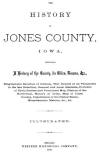 Û
History of Jones County, Iowa
Û
History of Jones County, Iowa
 Western
Historical Company, 1879.
Western
Historical Company, 1879.
The 1879 History of Jones County Iowa was transcribed by Janet A. Brandt
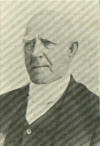 |
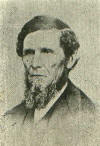 |
| James A Bronson | S. K. Toutellot |
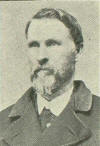 |
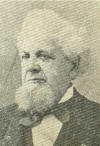 |
| Thomas Green | R. S. Williams |
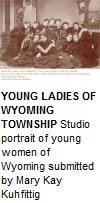 The flourishing
town of Wyoming is very pleasantly situated in the southwestern portion
of the township of the same name, and numbers at least a thousand souls,
nearly all of whom are Americans. The place was settled by emigrants
from the States of New York and Ohio. The Bear Creek runs through the
town and joins the Wapsipinicon River, about four miles from the
corporation limits, and affords something of a water-power for the use
of the inhabitants. The business portion is on the east side of Bear
Creek, and the business houses being built of brick give to the place a
good substantial appearance. The public-school building and the church
edifices are plain, simple and commodious, and bespeak that the
inhabitants prefer convenience and comfort above useless display and
architectural ornament. The place was incorporated as a city in 1873.
The flourishing
town of Wyoming is very pleasantly situated in the southwestern portion
of the township of the same name, and numbers at least a thousand souls,
nearly all of whom are Americans. The place was settled by emigrants
from the States of New York and Ohio. The Bear Creek runs through the
town and joins the Wapsipinicon River, about four miles from the
corporation limits, and affords something of a water-power for the use
of the inhabitants. The business portion is on the east side of Bear
Creek, and the business houses being built of brick give to the place a
good substantial appearance. The public-school building and the church
edifices are plain, simple and commodious, and bespeak that the
inhabitants prefer convenience and comfort above useless display and
architectural ornament. The place was incorporated as a city in 1873. This township is situated in the second tier
of townships from the south, west of the township of Wyoming. The
surface in general is smooth and unbroken, in parts rolling, and there
is a range of low hills extending east and west through the center.
There is but little timber in the township, and the inhabitants depend
in a measure on the adjoining towns for wood for fuel. The farmhouses
are good, the farms well cultivated, and the soil as fertile as in any
part of the county. Bear Creek crosses the southern part from west to
east, and a branch of Mineral Creek has its source in this township. The
township makes a fine display of good schoolhouses, and the employment
of good teachers bespeaks a commendable interest in the education of the
rising generation.
This township is situated in the second tier
of townships from the south, west of the township of Wyoming. The
surface in general is smooth and unbroken, in parts rolling, and there
is a range of low hills extending east and west through the center.
There is but little timber in the township, and the inhabitants depend
in a measure on the adjoining towns for wood for fuel. The farmhouses
are good, the farms well cultivated, and the soil as fertile as in any
part of the county. Bear Creek crosses the southern part from west to
east, and a branch of Mineral Creek has its source in this township. The
township makes a fine display of good schoolhouses, and the employment
of good teachers bespeaks a commendable interest in the education of the
rising generation. 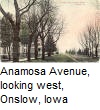 The village of Onslow is in the northwest portion of
Wyoming and the northeastern part of Madison, a part in both townships.
E. M. Franks, who settled in Wyoming Township some years ago, and become
a large land-holder, was the proprietor of the town. The site was laid
off into lots and the village begun, in the spring of 1872, on the
completion of the Midland Branch of the Chicago & North-Western Railway
to this point. Mr. Franks died two years ago.
The village of Onslow is in the northwest portion of
Wyoming and the northeastern part of Madison, a part in both townships.
E. M. Franks, who settled in Wyoming Township some years ago, and become
a large land-holder, was the proprietor of the town. The site was laid
off into lots and the village begun, in the spring of 1872, on the
completion of the Midland Branch of the Chicago & North-Western Railway
to this point. Mr. Franks died two years ago.  This is
the southeastern township of the county. The Wapsipinicon River enters
the township from the west, at about the center of the north and south
line, and, crossing diagonally, leaves the township about a half-mile
west of the southeast corner. The township, like all others in the
county, is well watered. Along the Wapsipinicon there is sufficient
timber for the ordinary uses of the inhabitants. Much of the land that
was too wet for farming purposes years ago, now constitutes a part of
the best land in the county. The township is well settled by emigrants
from the Eastern States, and there is quite a large settlement of
Bohemians.
This is
the southeastern township of the county. The Wapsipinicon River enters
the township from the west, at about the center of the north and south
line, and, crossing diagonally, leaves the township about a half-mile
west of the southeast corner. The township, like all others in the
county, is well watered. Along the Wapsipinicon there is sufficient
timber for the ordinary uses of the inhabitants. Much of the land that
was too wet for farming purposes years ago, now constitutes a part of
the best land in the county. The township is well settled by emigrants
from the Eastern States, and there is quite a large settlement of
Bohemians.  The village of
Oxford Junction is situated about a mile north of the river, near the
center of the township, and at the junction of the two branches of the
Chicago, Milwaukee & St. Paul Railway, and contains near two hundred
inhabitants. The site was laid off into village lots in 1871, by John
Bryan. Since that time, two small additions have been laid out; one by
Bryan and one by George Wilson. The C., M & St. P. Company recently
purchased land at this point, and the machine-shops, etc., for those
divisions are to be located here. This gives to the village an air of
importance, and the prospects of its improvement are quite flattering.
Already building has commenced, and another addition is to be made to
the town soon. The village now contains one school of fifty pupils, a
recently established newspaper, one church, erected by the Lutheran
Church society four years ago, three dry-goods stores, one drug store,
one hardware store, one restaurant, two meat markets, one harness-shop,
three grain ware-houses, two wagon and blacksmith shops, three
shoe-shops, one hotel and three saloons.
The village of
Oxford Junction is situated about a mile north of the river, near the
center of the township, and at the junction of the two branches of the
Chicago, Milwaukee & St. Paul Railway, and contains near two hundred
inhabitants. The site was laid off into village lots in 1871, by John
Bryan. Since that time, two small additions have been laid out; one by
Bryan and one by George Wilson. The C., M & St. P. Company recently
purchased land at this point, and the machine-shops, etc., for those
divisions are to be located here. This gives to the village an air of
importance, and the prospects of its improvement are quite flattering.
Already building has commenced, and another addition is to be made to
the town soon. The village now contains one school of fifty pupils, a
recently established newspaper, one church, erected by the Lutheran
Church society four years ago, three dry-goods stores, one drug store,
one hardware store, one restaurant, two meat markets, one harness-shop,
three grain ware-houses, two wagon and blacksmith shops, three
shoe-shops, one hotel and three saloons. This
village, of near the size of the Junction, is situated on the south bank
of the Wapsipinicon, a mile south of the above place. Its name is
derived from the flouring-mill erected here about the year 1857, by
Messrs. Courtright & Lathrop. It is a three-story wood building and
contains the modern appointments of a first-class mill. The property has
changed hands at sundry times, and is owned by S. F. McDonald, Esq. The
Wapsipinicon at this point affords an excellent water-power, which, if
utilized more fully, would greatly benefit the town. Messrs. Cartwright
& Bristol are the proprietors of a large general store; there are two
drug stores in the village, one public school, and the Methodist Church
society has a good house of worship. There is also a hotel and the usual
shops found in a village of the size.
This
village, of near the size of the Junction, is situated on the south bank
of the Wapsipinicon, a mile south of the above place. Its name is
derived from the flouring-mill erected here about the year 1857, by
Messrs. Courtright & Lathrop. It is a three-story wood building and
contains the modern appointments of a first-class mill. The property has
changed hands at sundry times, and is owned by S. F. McDonald, Esq. The
Wapsipinicon at this point affords an excellent water-power, which, if
utilized more fully, would greatly benefit the town. Messrs. Cartwright
& Bristol are the proprietors of a large general store; there are two
drug stores in the village, one public school, and the Methodist Church
society has a good house of worship. There is also a hotel and the usual
shops found in a village of the size.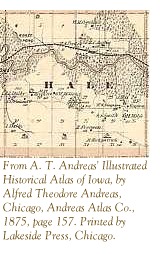 This
township was named in honor of the Hon. J. P. Hale, at the suggestion of
Daniel Garrison, who was the first settler of the township. The township
of Hale is situated west of Oxford and east of Rome, in the southern
tier of townships in the county. The Wapsipinicon River crosses the
township from west to east, and divides it into two nearly equal parts.
Along the river there is considerable timber and there are a number of
small groves; so that the township may be said to be well timbered. A
good supply of building stone is found in the township and the quality
is most excellent. A good share of the surface is beautiful, rolling
prairie land, and the farms are in a good state of cultivation. There
are three church edifices in the township; one at Pleasant Hill, one two
miles southeast of that place and one at the small village of Hale. The
first settlement south of the river was at what is now called Pleasant
Hill, and, as stated, Daniel Garrison and family were the first
settlers. Mr. Garrison emigrated from the State of Indiana, and came
into Hale Township in the month of June, 1838. Pleasant Grove and the
land south of it was claimed by a colored man in the year 1837, and for
many years the place has been known as "Negro Point." The name was
changed to Pleasant Hill at the suggestion of Miss Martha Miller, and to
the satisfaction of the people of the neighborhood. The church at this
place is called the Pleasant Hill Church, and the Sunday school,
Pleasant Hill Sunday School. Daniel Garrison built the first log cabin
the neighborhood, and the house is still standing, though it is more
than forty years old. Horace Seeley came in the spring of 1839, and
Lawrence Simpson and William Simpson in the fall of the same year.
Lawrence Simpson was once County Surveyor. Joseph Bumgarner came in
1840, M. Q. Simpson and Silas Garrison in 1842.
This
township was named in honor of the Hon. J. P. Hale, at the suggestion of
Daniel Garrison, who was the first settler of the township. The township
of Hale is situated west of Oxford and east of Rome, in the southern
tier of townships in the county. The Wapsipinicon River crosses the
township from west to east, and divides it into two nearly equal parts.
Along the river there is considerable timber and there are a number of
small groves; so that the township may be said to be well timbered. A
good supply of building stone is found in the township and the quality
is most excellent. A good share of the surface is beautiful, rolling
prairie land, and the farms are in a good state of cultivation. There
are three church edifices in the township; one at Pleasant Hill, one two
miles southeast of that place and one at the small village of Hale. The
first settlement south of the river was at what is now called Pleasant
Hill, and, as stated, Daniel Garrison and family were the first
settlers. Mr. Garrison emigrated from the State of Indiana, and came
into Hale Township in the month of June, 1838. Pleasant Grove and the
land south of it was claimed by a colored man in the year 1837, and for
many years the place has been known as "Negro Point." The name was
changed to Pleasant Hill at the suggestion of Miss Martha Miller, and to
the satisfaction of the people of the neighborhood. The church at this
place is called the Pleasant Hill Church, and the Sunday school,
Pleasant Hill Sunday School. Daniel Garrison built the first log cabin
the neighborhood, and the house is still standing, though it is more
than forty years old. Horace Seeley came in the spring of 1839, and
Lawrence Simpson and William Simpson in the fall of the same year.
Lawrence Simpson was once County Surveyor. Joseph Bumgarner came in
1840, M. Q. Simpson and Silas Garrison in 1842. 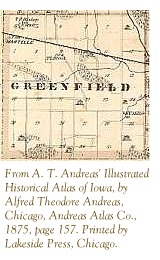 This is the southwestern township of the county. The surface is
generally even and unbroken, and the soil as fertile as any in the
county or State. A number of small but beautiful groves, pleasantly
distributed, constitute the only timber-land in the township. It is well
watered by the north and the south fork of Walnut Creek and their
tributaries.
This is the southwestern township of the county. The surface is
generally even and unbroken, and the soil as fertile as any in the
county or State. A number of small but beautiful groves, pleasantly
distributed, constitute the only timber-land in the township. It is well
watered by the north and the south fork of Walnut Creek and their
tributaries.  The Sabula, Ackley & Dakota Branch of the C. M. & St.
Paul Railroad crosses the north part of the township, and the small
village of Martelle is situated on this road, in the northwest corner of
the township. There are about one hundred inhabitants, two general
stores, one drug store, one wagon-shop, one blacksmith-shop, one
hardware store, one school, and the Christian Church has a good church
edifice. The Baptist society also worships in the same building. There
are two other churches in the township, one near the center and another
in the southern part. There are a goodly number of Germans in the
township, and, as elsewhere, they are among the most prosperous citizens
in the county. The education of the rising generation is well cared for
by erecting schoolhouses and the employment of faithful teachers.
The Sabula, Ackley & Dakota Branch of the C. M. & St.
Paul Railroad crosses the north part of the township, and the small
village of Martelle is situated on this road, in the northwest corner of
the township. There are about one hundred inhabitants, two general
stores, one drug store, one wagon-shop, one blacksmith-shop, one
hardware store, one school, and the Christian Church has a good church
edifice. The Baptist society also worships in the same building. There
are two other churches in the township, one near the center and another
in the southern part. There are a goodly number of Germans in the
township, and, as elsewhere, they are among the most prosperous citizens
in the county. The education of the rising generation is well cared for
by erecting schoolhouses and the employment of faithful teachers. The following, from the pen of the late R. J.
Cleaveland, will be read and appreciated by all who had the pleasure of
his acquaintance. Mr. Cleaveland was born in Boston, Mass., in November,
1805, and died at his residence in Olin, Jones County, on the 7th of
September, A. D. 1877, at the age of nearly seventy-two years. He
graduated at Harvard University in the class of 1827, and was a ripe
scholar, a genuine patriot and an honest man. At the outbreak of the
civil war, he sought to enlist as a volunteer, but was rejected because
of his age. He was finally admitted to the ranks of the famous Iowa
ninth, and, with that regiment, served until it was mustered out of
service. It was due to his acquaintance at Boston that the ladies of
that city presented to the regiment the magnificent colors, the details
of which are related in the war history of the county, elsewhere.
The following, from the pen of the late R. J.
Cleaveland, will be read and appreciated by all who had the pleasure of
his acquaintance. Mr. Cleaveland was born in Boston, Mass., in November,
1805, and died at his residence in Olin, Jones County, on the 7th of
September, A. D. 1877, at the age of nearly seventy-two years. He
graduated at Harvard University in the class of 1827, and was a ripe
scholar, a genuine patriot and an honest man. At the outbreak of the
civil war, he sought to enlist as a volunteer, but was rejected because
of his age. He was finally admitted to the ranks of the famous Iowa
ninth, and, with that regiment, served until it was mustered out of
service. It was due to his acquaintance at Boston that the ladies of
that city presented to the regiment the magnificent colors, the details
of which are related in the war history of the county, elsewhere.  Olin, named after D.
A. Olin, General Superintendent of the Chicago, Milwaukee & St. Paul
Railroad, is beautifully located on the west bank of the Wapsipinicon
River, upon the central portion of Section 13 in Rome Township. It was
first called Elkford, then Walnut Fork, afterward Rome, and now Olin. It
is an important shipping-point on the Milwaukee & St. Paul Railroad,
containing a population of about seven hundred inhabitants. It is
surrounded by a beautiful rolling prairie, occupied by a thrifty farming
community. It has a good grist-mill, a woolen-mill, prosperous schools
and churches, and the Olin College has recently been organized and
incorporated, and will soon have a commodious and comfortable college
building. A public library and reading-room are contemplated. The city
of Olin was incorporated in 1878. The following are the city officers:
Mayor, N. Barnhard; Recorder, H. Jeffries; Treasurer, Samuel Easterly.
Council—J. A. White, J. W. Jamison, James Dayton, C. L. Porter, W. H.
Dicus, William Scoles. The Council are strictly temperate men.
Olin, named after D.
A. Olin, General Superintendent of the Chicago, Milwaukee & St. Paul
Railroad, is beautifully located on the west bank of the Wapsipinicon
River, upon the central portion of Section 13 in Rome Township. It was
first called Elkford, then Walnut Fork, afterward Rome, and now Olin. It
is an important shipping-point on the Milwaukee & St. Paul Railroad,
containing a population of about seven hundred inhabitants. It is
surrounded by a beautiful rolling prairie, occupied by a thrifty farming
community. It has a good grist-mill, a woolen-mill, prosperous schools
and churches, and the Olin College has recently been organized and
incorporated, and will soon have a commodious and comfortable college
building. A public library and reading-room are contemplated. The city
of Olin was incorporated in 1878. The following are the city officers:
Mayor, N. Barnhard; Recorder, H. Jeffries; Treasurer, Samuel Easterly.
Council—J. A. White, J. W. Jamison, James Dayton, C. L. Porter, W. H.
Dicus, William Scoles. The Council are strictly temperate men.  There are four church organizations-Methodist, Baptist, United Brethern
and Advent. The Methodist denomination has a commodious church edifice.
The Baptist and Advents hold services in the public-school building. The
Pastor of the Methodist Church is Rev. J. Hurrell. None of the other
denominations have a settled Pastor.
There are four church organizations-Methodist, Baptist, United Brethern
and Advent. The Methodist denomination has a commodious church edifice.
The Baptist and Advents hold services in the public-school building. The
Pastor of the Methodist Church is Rev. J. Hurrell. None of the other
denominations have a settled Pastor.  The studies taught in the various courses are: Fundamental-Reading,
Spelling, Writing, Grammar, United States History, Drawing, Rhetoric,
Logic, Elocution, Mental and Moral Science, Theory and Practice of
Teaching, Constitution of the United States. Mathematics-Arithmetic,
Book-Keeping, Algebra, Geometry, Trigonometry, Mensuration, Surveying,
Conic Sections, Calculus. Natural Sciences-Geography, Geology,
Mineralogy, Physiology, Botany, Natural History, Astronomy.
Languages-Greek, Latin, French and German. Music-Vocal and Instrumental.
The studies taught in the various courses are: Fundamental-Reading,
Spelling, Writing, Grammar, United States History, Drawing, Rhetoric,
Logic, Elocution, Mental and Moral Science, Theory and Practice of
Teaching, Constitution of the United States. Mathematics-Arithmetic,
Book-Keeping, Algebra, Geometry, Trigonometry, Mensuration, Surveying,
Conic Sections, Calculus. Natural Sciences-Geography, Geology,
Mineralogy, Physiology, Botany, Natural History, Astronomy.
Languages-Greek, Latin, French and German. Music-Vocal and Instrumental.
 C. L. Porter, A. M., Principal (biographical sketch elsewhere),
is a graduate of Amherst College, has been a professional teacher for
sixteen years, and is thoroughly recommended by the State Superintendent
and others. Miss Laura J Hendy, teacher of music, is a skillful teacher
of the piano and organ. The teacher of the Preparatory Department has
not yet been selected. Other teachers and professors will be added as
occasion may require. The Bible is the corner-stone of this institution.
C. L. Porter, A. M., Principal (biographical sketch elsewhere),
is a graduate of Amherst College, has been a professional teacher for
sixteen years, and is thoroughly recommended by the State Superintendent
and others. Miss Laura J Hendy, teacher of music, is a skillful teacher
of the piano and organ. The teacher of the Preparatory Department has
not yet been selected. Other teachers and professors will be added as
occasion may require. The Bible is the corner-stone of this institution.


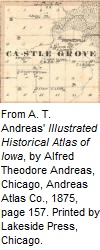 This township, according to the United
States survey, is numbered 86 north, west of Range 4.
This township, according to the United
States survey, is numbered 86 north, west of Range 4. 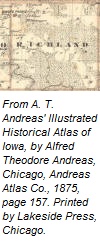 This
township is east of Monticello and west of Washington, and is one of the
first settled in the county. The south fork of the Maquoketa River
crosses the southwest corner of the township, and by this means and
numerous creeks, the whole is well watered. About one-third of the area
is as fine prairie land as there is in the State, and the balance is
timber-land. The prairie is in the northwest corner, and here the
village of Bowen's Prairie is situated. Twenty years ago, this was a
village of considerable importance, but the building-up of the town of
Monticello caused the removal of businesses to that place. The following
heads of families are found at Bowen's Prairie Village: E. S. Blodgett,
Cyrus Whittemore, William Whittemore, Widow Heims, Frederick Pennaman,
N. C. Rowley and James Craig. N. C. Rowley is the Postmaster. There are
two churches in the village and a German Church in the western portion
of the township, about two miles south of Bowen's Prairie. We were
unable to get the history of the Methodist Church at the village, or the
German Church, when we were in that part of the county.
This
township is east of Monticello and west of Washington, and is one of the
first settled in the county. The south fork of the Maquoketa River
crosses the southwest corner of the township, and by this means and
numerous creeks, the whole is well watered. About one-third of the area
is as fine prairie land as there is in the State, and the balance is
timber-land. The prairie is in the northwest corner, and here the
village of Bowen's Prairie is situated. Twenty years ago, this was a
village of considerable importance, but the building-up of the town of
Monticello caused the removal of businesses to that place. The following
heads of families are found at Bowen's Prairie Village: E. S. Blodgett,
Cyrus Whittemore, William Whittemore, Widow Heims, Frederick Pennaman,
N. C. Rowley and James Craig. N. C. Rowley is the Postmaster. There are
two churches in the village and a German Church in the western portion
of the township, about two miles south of Bowen's Prairie. We were
unable to get the history of the Methodist Church at the village, or the
German Church, when we were in that part of the county. 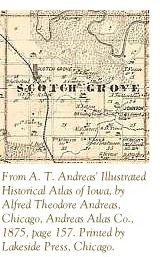 The first
settlement in this township was made in 1836 or 1837, and, consequently,
Scotch Grove is one of the very earliest settled districts in the
county. The first settlers were Scotch emigrants from the Selkirk
settlements, in British America, on the Red River of the North. They are
said to have traveled the whole distance in ox-carts of the most
antiquated style of construction. The hardships and privations incident
to their journey-nearly a thousand miles-were numerous, and such as must
have tried the very souls of these hardy pioneers to an extent that
entitles them to the everlasting respect of all who now enjoy the
advantages of this rich and populous district of the county of Jones.
The indomitable will and courageous spirit of these early settlers have
stamped their impress upon the character of the district in which they
located, that will continue to be felt for a long time to come. The
honor that is justly their due has never been paid to them, and the
passing notice we give to them is by no means commensurate with their
just deserts.
The first
settlement in this township was made in 1836 or 1837, and, consequently,
Scotch Grove is one of the very earliest settled districts in the
county. The first settlers were Scotch emigrants from the Selkirk
settlements, in British America, on the Red River of the North. They are
said to have traveled the whole distance in ox-carts of the most
antiquated style of construction. The hardships and privations incident
to their journey-nearly a thousand miles-were numerous, and such as must
have tried the very souls of these hardy pioneers to an extent that
entitles them to the everlasting respect of all who now enjoy the
advantages of this rich and populous district of the county of Jones.
The indomitable will and courageous spirit of these early settlers have
stamped their impress upon the character of the district in which they
located, that will continue to be felt for a long time to come. The
honor that is justly their due has never been paid to them, and the
passing notice we give to them is by no means commensurate with their
just deserts. The first settlers were John and Alexander
Sutherland, Joseph Bremner, Alexander McLlain and David McCoy. After
these came Ebenezer Sutherland, Donald Sutherland and Donald Sinclair,
who came in about 1838. Donald Livingston came in 1840, and settled near
what is now the poor farm on the west side of Scotch Grove. About 1843,
M. H. Hutton, and, somewhat later, L. J. Dreibelbis and Mathew Dawson
settled in the township. In 1841, John E. Lovejoy, who had settled in
Clay Township in 1839, came into Scotch Grove, and is still a resident,
though he has at times been a resident of other portions of the country
for a time, and was, for three years and a half, Consul to Peru, under
the appointment of President Lincoln.
The first settlers were John and Alexander
Sutherland, Joseph Bremner, Alexander McLlain and David McCoy. After
these came Ebenezer Sutherland, Donald Sutherland and Donald Sinclair,
who came in about 1838. Donald Livingston came in 1840, and settled near
what is now the poor farm on the west side of Scotch Grove. About 1843,
M. H. Hutton, and, somewhat later, L. J. Dreibelbis and Mathew Dawson
settled in the township. In 1841, John E. Lovejoy, who had settled in
Clay Township in 1839, came into Scotch Grove, and is still a resident,
though he has at times been a resident of other portions of the country
for a time, and was, for three years and a half, Consul to Peru, under
the appointment of President Lincoln. At the time of the first
settlement, there were no houses between the military road and Canton.
The nearest market was Dubuque, and the nearest mill at Catfish Creek,
and was a very poor excuse for a mill at that. The places now called
cities were almost without inhabitant. Maquoketa had a few settlers
about it, and Dubuque was a mere hamlet. A few accessions were made
occasionally until 1850, when some pioneers arrived from Indiana and
Pennsylvania, and the spies having sent back a favorable report, others
followed thick and fast, and now the township is thickly settled. Taken
as a whole, it may be said that this township is unsurpassed for beauty
of location by any in the county, and but few, if any, in the State. The
South Fork of the Maquoketa waters the township on the north, along
which there is good timber. Mineral Creek waters it in the southeast,
and another small stream runs through about the center. The soil is a
black, sandy loam, yielding abundantly to the cultivator, though it
requires care and attention to develop its full resources. The
inhabitants are, as a rule, a moral, temperate and industrious people.
During the late civil war, Scotch Grove was among the first in the
county to send volunteers to the front, to fight for the preservation of
the Union, and she continued equally patriotic throughout the long
struggle.
At the time of the first
settlement, there were no houses between the military road and Canton.
The nearest market was Dubuque, and the nearest mill at Catfish Creek,
and was a very poor excuse for a mill at that. The places now called
cities were almost without inhabitant. Maquoketa had a few settlers
about it, and Dubuque was a mere hamlet. A few accessions were made
occasionally until 1850, when some pioneers arrived from Indiana and
Pennsylvania, and the spies having sent back a favorable report, others
followed thick and fast, and now the township is thickly settled. Taken
as a whole, it may be said that this township is unsurpassed for beauty
of location by any in the county, and but few, if any, in the State. The
South Fork of the Maquoketa waters the township on the north, along
which there is good timber. Mineral Creek waters it in the southeast,
and another small stream runs through about the center. The soil is a
black, sandy loam, yielding abundantly to the cultivator, though it
requires care and attention to develop its full resources. The
inhabitants are, as a rule, a moral, temperate and industrious people.
During the late civil war, Scotch Grove was among the first in the
county to send volunteers to the front, to fight for the preservation of
the Union, and she continued equally patriotic throughout the long
struggle. 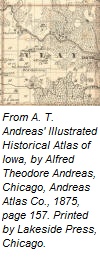 Clay is one of the oldest-settled townships in
the county. The first permanent settlers were David Killam, John E.
Holmes, Benjamin Collins, Truman Brown and Madison Brown, who were here
before 1838. John E. Lovejoy, now of Scotch Grove, came in 1839; P. D.
Turner and Horace Turner came the same year, and, in the following
spring, Lyman Turner, the father of P. D. and Horace. From 1840 to 1850,
a few settlers came in, but in the latter year, the tide of emigrants
which came pouring West, reached that place, and Clay Township was
rapidly settled from that time on. A small portion of the village of
Canton is in this township, and Canton may be called the commercial
center. In early years, considerable lumber was manufactured at Canton.
The South Fork of the Maquoketa enters the township at the northwest
corner, and crossing to the east, leaves the township at the village of
Canton. Along the river there is a good body of timber. The land along
the river is a good deal broken and some of it rather sandy, but where
it can be tilled gives good crops. Mineral Creek runs through the
township near the south side, entering it near the north line of Section
31, and leaving it about a mile and a half north of the southeast corner
of the township. The land in the prairie districts is abundantly
productive, and the township is well watered and timbered.
Clay is one of the oldest-settled townships in
the county. The first permanent settlers were David Killam, John E.
Holmes, Benjamin Collins, Truman Brown and Madison Brown, who were here
before 1838. John E. Lovejoy, now of Scotch Grove, came in 1839; P. D.
Turner and Horace Turner came the same year, and, in the following
spring, Lyman Turner, the father of P. D. and Horace. From 1840 to 1850,
a few settlers came in, but in the latter year, the tide of emigrants
which came pouring West, reached that place, and Clay Township was
rapidly settled from that time on. A small portion of the village of
Canton is in this township, and Canton may be called the commercial
center. In early years, considerable lumber was manufactured at Canton.
The South Fork of the Maquoketa enters the township at the northwest
corner, and crossing to the east, leaves the township at the village of
Canton. Along the river there is a good body of timber. The land along
the river is a good deal broken and some of it rather sandy, but where
it can be tilled gives good crops. Mineral Creek runs through the
township near the south side, entering it near the north line of Section
31, and leaving it about a mile and a half north of the southeast corner
of the township. The land in the prairie districts is abundantly
productive, and the township is well watered and timbered. 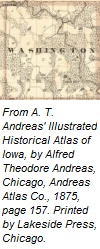 There are but few counties in which there is no Washington Township, and
Jones County is no exception to the rule. This is the northeast township
of the county, and is one of the first settled portions in it. The north
fork of the Maquoketa River enters the northeast corner, crosses to the
southeast and leaves the township about a half-mile north of the
southeast corner. The Whitewater branch of the Maquoketa enters the
township from the north, a mile west of the northeast corner, and unites
with the latter in the north part of Section 10. Farm Creek crosses the
southwest portion, and, entering Clay Township on the south, empties
into the south fork of the Maquoketa a little north of the center of
that township.
There are but few counties in which there is no Washington Township, and
Jones County is no exception to the rule. This is the northeast township
of the county, and is one of the first settled portions in it. The north
fork of the Maquoketa River enters the northeast corner, crosses to the
southeast and leaves the township about a half-mile north of the
southeast corner. The Whitewater branch of the Maquoketa enters the
township from the north, a mile west of the northeast corner, and unites
with the latter in the north part of Section 10. Farm Creek crosses the
southwest portion, and, entering Clay Township on the south, empties
into the south fork of the Maquoketa a little north of the center of
that township. 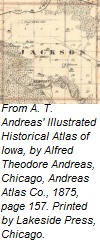 This township is east of Fairview and west
of Madison. The surface is, largely, rolling prairie land; in parts it
is somewhat broken. The Wapsipinicon River enters from the west, near
the center, and running southeast, leaves the township a mile west of
the southeast corner. Along the river, there is good timber-land, and
there is considerable timber in the northeast corner. The village of
Newport is in the south part, on the Wapsipinicon, and consists, at the
present time, of only a small collection of dwellings and a grist-mill.
There is an excellent water-power at this point, and this village was
once the county seat. One of the finest bridges spans the Wapsipinicon
at this place that there is in the county. It is an iron structure, and
rests upon good, solid, stone abutments.
This township is east of Fairview and west
of Madison. The surface is, largely, rolling prairie land; in parts it
is somewhat broken. The Wapsipinicon River enters from the west, near
the center, and running southeast, leaves the township a mile west of
the southeast corner. Along the river, there is good timber-land, and
there is considerable timber in the northeast corner. The village of
Newport is in the south part, on the Wapsipinicon, and consists, at the
present time, of only a small collection of dwellings and a grist-mill.
There is an excellent water-power at this point, and this village was
once the county seat. One of the finest bridges spans the Wapsipinicon
at this place that there is in the county. It is an iron structure, and
rests upon good, solid, stone abutments. 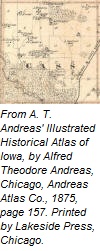 This township is north of
Fairview, and, though not the earliest settled, comprises a portion of
the very best farming land in the county. The south portion is
considerably broken, and is principally timber-land, and a small
district in north is likewise hilly and uneven. The central portion is a
beautiful prairie district, almost entirely level or slightly
undulating. The farms are in a good state of cultivation, and the
farmhouses and barns good and substantial. The Buffalo Creek runs across
the southwest corner, and the Dubuque & Southwestern Branch of the
Chicago & Milwaukee & St. Paul Railway crosses the southwest. In the
center of the township the Congregational Church society has a good
house of worship, and there is a Methodist Church two miles north of the
center. In the southwestern portion there is one of the most flourishing
creameries in the county, owned and operated by Messrs. Stuart &
Chadwick. Among the early settlers of this township were Elisha Dodge,
now of Monticello, Solomon Thomas, Mr. Pitcher, George Hall, Alex.
Crawford, A. P. Condit, John Powell, M. Reaves, Linus Osborne, David
Osborne, John Reaves, Silas Samms, Jonas Samms, Robert Dondit, Oliver
Doyle, Mr. Acres, John Wallace and others.
This township is north of
Fairview, and, though not the earliest settled, comprises a portion of
the very best farming land in the county. The south portion is
considerably broken, and is principally timber-land, and a small
district in north is likewise hilly and uneven. The central portion is a
beautiful prairie district, almost entirely level or slightly
undulating. The farms are in a good state of cultivation, and the
farmhouses and barns good and substantial. The Buffalo Creek runs across
the southwest corner, and the Dubuque & Southwestern Branch of the
Chicago & Milwaukee & St. Paul Railway crosses the southwest. In the
center of the township the Congregational Church society has a good
house of worship, and there is a Methodist Church two miles north of the
center. In the southwestern portion there is one of the most flourishing
creameries in the county, owned and operated by Messrs. Stuart &
Chadwick. Among the early settlers of this township were Elisha Dodge,
now of Monticello, Solomon Thomas, Mr. Pitcher, George Hall, Alex.
Crawford, A. P. Condit, John Powell, M. Reaves, Linus Osborne, David
Osborne, John Reaves, Silas Samms, Jonas Samms, Robert Dondit, Oliver
Doyle, Mr. Acres, John Wallace and others.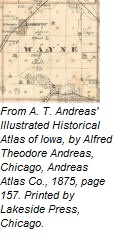 This
fine agricultural township lies immediately south of Monticello and
northeast of Anamosa. It is surpassed by none in the fertility of its
soil and the character of its inhabitants. While in many portions of the
township the land is comparatively level, yet, as a whole, it is
abruptly rolling and uneven, interspersed with rich lowlands and lined
by several small ravines. Primeval forests are not found, but areas of
thrifty young timber are not rare. Nearly all the land is tillable, and
is watered by Kitty Creek with its two main branches and their small
tributaries. The southern sections constitute a "ridge" or water-shed
from which small streams flow northward, and others to the southeast.
The township is traversed by no river. The soil is generally a sandy
loam, which produces excellent small grain, fair corn, good grass, and
nearly all the varieties of fruit which are adapted to this latitude.
Areas of alluvial soil yield premium corn. Their luxuriant meadows and
cultivated grasses supply winter food for the cattle gathered in from
their "thousand hills." The township is well adapted to general farming
and the dairy business, which latter interest is rapidly becoming
prominent.
This
fine agricultural township lies immediately south of Monticello and
northeast of Anamosa. It is surpassed by none in the fertility of its
soil and the character of its inhabitants. While in many portions of the
township the land is comparatively level, yet, as a whole, it is
abruptly rolling and uneven, interspersed with rich lowlands and lined
by several small ravines. Primeval forests are not found, but areas of
thrifty young timber are not rare. Nearly all the land is tillable, and
is watered by Kitty Creek with its two main branches and their small
tributaries. The southern sections constitute a "ridge" or water-shed
from which small streams flow northward, and others to the southeast.
The township is traversed by no river. The soil is generally a sandy
loam, which produces excellent small grain, fair corn, good grass, and
nearly all the varieties of fruit which are adapted to this latitude.
Areas of alluvial soil yield premium corn. Their luxuriant meadows and
cultivated grasses supply winter food for the cattle gathered in from
their "thousand hills." The township is well adapted to general farming
and the dairy business, which latter interest is rapidly becoming
prominent.